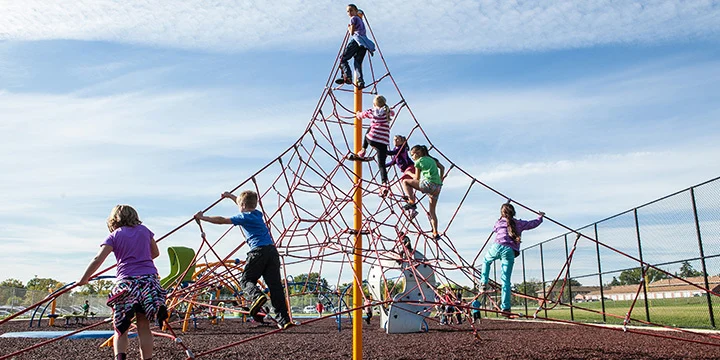Introduction
Modern playgrounds are rapidly transforming to become more dynamic, inclusive, and beneficial for children’s holistic development. At the heart of this evolution is the integration of cargo climbing nets, which have emerged as essential features in playground design. These robust structures are more than play equipment; they are vibrant hubs where children’s imaginations flourish, social bonds are forged, and bodies grow strong. Cargo climbing nets invite adventurous play in a captivating and secure way, challenging kids to overcome obstacles, work collaboratively, and build self-confidence with every climb. By thoughtfully incorporating these nets into public play spaces, communities are making a conscious investment in their youngest members’ physical, emotional, and cognitive growth.
This detailed guide will explain the multifaceted benefits of cargo climbing nets and provide insights into selecting the right materials, implementing vital safety measures, and crafting playful environments for children of all ages. By understanding the design and purpose of climbing nets, community leaders, parents, and playground planners can create engaging, safe, and memorable play experiences that meet the needs of every child.
Benefits of Cargo Climbing Nets
Cargo climbing nets are widely celebrated for their versatility in nurturing physical fitness, imaginative play, and robust social interaction. Children who encounter these nets are instantly enticed to climb, swing, and navigate to the top, developing crucial gross motor skills: balance, core strength, endurance, and flexibility. Unlike static playground features, the ever-changing routes and adjustable grips encourage young users to think critically, assess situations, and solve problems through physical trial and error. This blend of physical and cognitive challenge makes climbing nets a cornerstone for childhood development.
Inclusivity is a defining feature of climbing nets, thanks to their open-ended, accessible design that encourages independent exploration and cooperative group play. These structures welcome children of all abilities, fostering shared experiences and friendships. Whether installed in public parks, schoolyards, or themed adventure zones, climbing nets serve various ages and skill levels. Choosing high-quality climbing and safety nets ensures a secure, stimulating environment that parents and caregivers trust. Beyond entertainment, well-crafted nets help children build essential life skills—confidence, leadership, and perseverance—beyond the playground.
Choosing the Right Materials
One of the most important considerations in playground planning is material selection for climbing nets. The longevity, safety, and comfort of the climbing experience are directly linked to the quality and characteristics of the materials chosen. Various ropes and webbings each have particular strengths suited for different playground settings:
- Polyester:Praised for its remarkable UV resistance and durability against unpredictable weather, polyester maintains its vibrant color and sturdy texture even with constant, high-traffic use. It stands up well to strong sunlight, heavy rainfall, and fluctuating temperatures, making it ideal for outdoor applications that require minimal upkeep.
- Nylon:Known for its exceptional strength and slight elasticity, nylon rope can absorb shock and impact, adding a dynamic element to climbing. However, because it tends to retain moisture, nylon is best suited for playgrounds with good drainage or indoor installations, as persistent dampness can reduce its resilience over time.
- Polypropylene:This lightweight and highly water-resistant material is a cost-effective solution for playgrounds with moderate use, such as residential areas or small parks. However, it may not offer the same long-term robustness as polyester or nylon in spaces with constant, intense activity.
- Manila Rope:Made from natural fibers, manila ropes provide a rustic, organic aesthetic that appeals to designers seeking a traditional look. Despite their strength, natural ropes are susceptible to rot, mildew, and weathering, necessitating diligent, ongoing maintenance—especially in outdoor, wet environments.
In most modern playgrounds, synthetic options like polyester emerge as the top choice due to their resistance to fading, minimal maintenance requirements, and proven safety. When selecting materials, it’s important to account for projected foot traffic, local weather conditions, and the need for easy upkeep to ensure the net continues to deliver safe, enjoyable play for years to come.
Safety Considerations
Ensuring child safety is the highest priority in playground design. Cargo climbing nets are only as safe as the thought and effort invested in their planning and upkeep. Several core safety practices should always be followed:
- Install suitable impact-absorbing surfacing—such as engineered wood fiber, rubber mulch, or poured-in-place rubber—below and around each net. This reduces the risk of serious injury from falls.
- Eliminate hazards by covering sharp edges, exposed bolts, or fasteners with protective shields. This step is crucial to prevent accidental cuts or entanglement.
- Encourage vigilant supervision, especially for younger or inexperienced climbers. Adequate adult presence ensures accidents are prevented or addressed quickly if they occur.
- Regularly instruct children on safe climbing techniques, such as using slow, calculated movements and ensuring proper hand and footholds. Teaching careful descent is just as vital as guiding children in ascent.
- Maintain a debris-free, dry climbing surface to minimize slipping, tripping, and falls.
Routine inspections are essential: check frequently for fraying ropes, loose anchoring, or rust on hardware. Immediate attention to damage or wear will prevent accidents and keep the climbing net a safe, enjoyable attraction for years. Guidelines and standards provided by industry organizations can further inform best practices. For more information on the safety and advantages of ropes and cargo nets, visit this resource.
Installation and Maintenance
Proper Installation
Proper installation lays the foundation for safe, long-lasting play. To ensure a secure structure, it’s strongly advised to work with professional installers familiar with playground safety standards and requirements. Many modern nets offer pre-assembled hardware for straightforward setup, but custom anchoring or supports may be required based on the unique characteristics of each space. Always refer to the manufacturer’s recommendations, local regulations, and the expertise of certified installers.
Ongoing Maintenance
Regular maintenance procedures keep climbing nets both attractive and functional. Simple tasks like rinsing off dirt and debris with water and mild soap help preserve traction and appearance. Pay close attention to parts most exposed to weather—look for signs of UV damage, color fading, brittleness, or mildew. Replace or repair damaged components right away to mitigate any hazards. Visual inspections should be conducted frequently, especially in high-traffic areas, to address wear and maximize the net’s service life promptly.
Designing for Various Age Groups
The adaptability of climbing nets means they can be engineered for children at every developmental stage. For toddlers and preschool-aged users, netting should feature small mesh openings, lower climbing heights, and gentle slopes to cultivate early coordination in a comfortable, safe setting. Older children, on the other hand, are drawn to heightened challenges—nets can be expanded with steeper inclines, suspended elements, or even multi-level climbing paths for greater excitement and skill-building.
Clearly visible signage that lists intended age groups and adult supervision requirements further ensures age-appropriate usage, reducing risks while maximizing enjoyment. This approach fosters a welcoming, inclusive play environment suited for the youngest and oldest adventurers alike.
Enhancing the Play Experience
The versatility of cargo climbing nets allows them to blend seamlessly with other playground elements, creating diverse and engaging play experiences. When paired with features like rope bridges, monkey bars, balance beams, and slides, climbing nets function as vital links in thrilling adventure courses. These interconnected systems support various games and collaborative activities, fostering teamwork, leadership, and imaginative problem-solving among children.
To further enrich the environment, playground designers may introduce themes—such as pirate ships, jungle treks, or space missions—using vibrant colors and playful motifs to spark storytelling and creative role play. By integrating climbing nets mindfully and creatively, designers help cultivate inclusive playgrounds where children are inspired to develop agility, resilience, creativity, and social skills while forging treasured friendships. For more inspiration on integrating playground nets and maximizing their benefits, discover additional ideas at this external resource.















